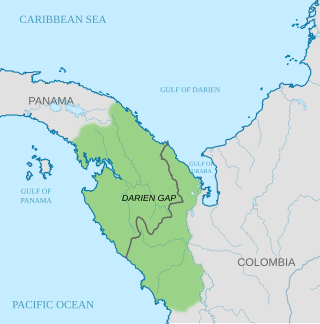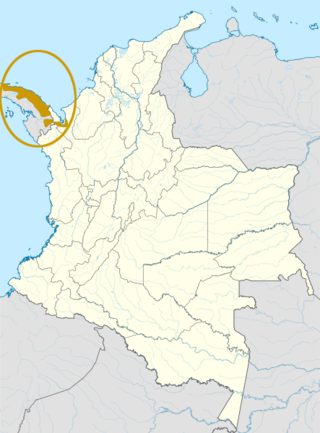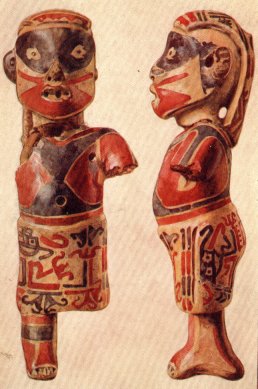
The history of Panama includes the history of the Isthmus of Panama prior to European colonization.

This is a demography of the population of Panama including population density, ethnicity, education level, health of the populace, economic status, religious affiliations, and other aspects of the population. Panama's 2020 census has been postponed due to the COVID-19 pandemic but the government are currently assessing additional implications. They are evaluating the preparatory processes that can begin now, such as procurement.

Guna Yala, formerly known as San Blas, is a comarca indígena in northeast Panama. Guna Yala is home to the indigenous people known as the Gunas. Its capital is Gaigirgordub. It is bounded on the north by the Caribbean Sea, on the south by the Darién Province and Emberá-Wounaan, on the east by Colombia, and on the west by the province of Colón.

The Darién Gap is a geographic region that connects the American continents, stretching across southern Panama's Darién Province and the northern portion of Colombia's Chocó Department. Consisting of a large watershed, dense rainforest, and mountains, it is known for its remoteness, difficult terrain, and extreme environment, with a reputation as one of the most inhospitable regions in the world. Nevertheless, as the only land bridge between North and South America, the Darién Gap has historically served as a major route for both humans and wildlife.

Darién is a province in Panama whose capital city is La Palma. With an area of 11,896.5 km2 (4,593.3 sq mi), it is located at the eastern end of the country and bordered to the north by the province of Panamá and the region of Kuna Yala. To the south, it is bordered by the Pacific Ocean and Colombia. To the east, it borders Colombia; to the west, it borders the Pacific Ocean and the province of Panama.

The Guna are an indigenous people of Panama and Colombia. Guna people live in three politically autonomous comarcas or autonomous reservations in Panama, and in a few small villages in Colombia. There are also communities of Guna people in Panama City, Colón, and other cities. Most Guna live on small islands off the coast of the comarca of Guna Yala known as the San Blas Islands. The other two Guna comarcas in Panama are Kuna de Madugandí and Kuna de Wargandí. They are Guna-speaking people who once occupied the central region of what is now Panama and the neighboring San Blas Islands and still survive in marginal areas.

The Isthmus of Panama, also historically known as the Isthmus of Darien, is the narrow strip of land that lies between the Caribbean Sea and the Pacific Ocean, linking North and South America. It contains the country of Panama and the Panama Canal. Like many isthmuses, it is a location of great geopolitical and strategic importance.
Isaac Grier Strain, an American midshipman. At age 17 he joined the U.S. Navy to apprentice at sea.

The Gulf of Darién is the southernmost region of the Caribbean Sea, located north and east of the border between Panama and Colombia. Within the gulf is the Gulf of Urabá, a small lip of sea extending southward, between Caribana Point and Cape Tiburón, Colombia, on the southern shores of which is the port city of Turbo, Colombia. The Atrato River delta extends into the Gulf of Darién.
Panamanian culture is a hybrid of African, Native Panamanian, and European culture - specifically Spanish. For example, the tamborito is a Spanish dance that was blended with Native American rhythms and dance moves. Dance is a symbol of the diverse cultures that have coupled in Panama. The local folklore can be experienced through a multitude of festivals, dances and traditions that have been handed down from generation to generation.

The Kuna language, spoken by the Kuna people of Panama and Colombia, belongs to the Chibchan language family.

Vasco Núñez de Balboa was a Spanish explorer, governor, and conquistador. He is best known for crossing the Isthmus of Panama to the Pacific Ocean in 1513, becoming the first European to lead an expedition to have seen or reached the Pacific from the New World.

Bartholomew Sharp was an English buccaneer and privateer. His career of piracy lasted seven years (1675–1682). In the Caribbean he took several ships, and raided the Gulf of Honduras and Portobelo. He took command of an expedition into the Pacific and spent months raiding settlements on the Pacific Coast of South America including La Serena which he torched in 1680. His flagship, taken at Panama, was the Trinity.

Matthew Williams Stirling was an American ethnologist, archaeologist and later an administrator at several scientific institutions in the field. He is best known for his discoveries relating to the Olmec civilization. Much of his work was done with his "wife and constant collaborator" of 42 years Marion Stirling.

In the history of Panama, the earliest known inhabitants were the Cueva and Coclé tribes, but they were drastically reduced by disease and fighting when the Spanish arrived in the 16th century. But some moved out of Panama to have children and increase population.
White Amazonian Indians or White Indians is a term first applied to sightings or encounters with mysterious white skinned natives of the Amazon Rainforest from the 16th century by Spanish missionaries. These encounters and tales sparked Percy Fawcett's journey into the uncharted jungle of the Amazonian Mato Grosso region. Various theories since the early 20th century have been proposed regarding the documented sightings or encounters.

The Emberá, also known in the historical literature as the Chocó or Katío Indians are an Indigenous people of Panama and Colombia. In the Emberá languages, the word ẽberá can be used to mean person, man, or indigenous person, depending on the context in which it is used. There are approximately 33,000 people living in Panama and 50,000 in Colombia who identify as Emberá.

The Colombia–Panama border is the 339-kilometer-long (211 mi) international boundary between Colombia and Panama. It also splits the Darién Gap, a break across the South American and North American continents. This large watershed, forest, and mountainous area is in the north-western portion of Colombia's Chocó Department and south-eastern portion of Panama's Darién Province.

The Eastern Panamanian montane forests (NT0122) is an ecoregion in the east of Panama and the extreme northwest of Colombia. It contains diverse flora and fauna, with considerable endemism. The ecoregion is largely intact due to its inaccessibility, although the opening of an extension of the Pan-American Highway has introduced threats from human activity.

The San Blas Rebellion, Guna Revolution or Revolution of Tule was an uprising by the Kuna, to declare independence, in the San Blas Islands, in February 1925.















